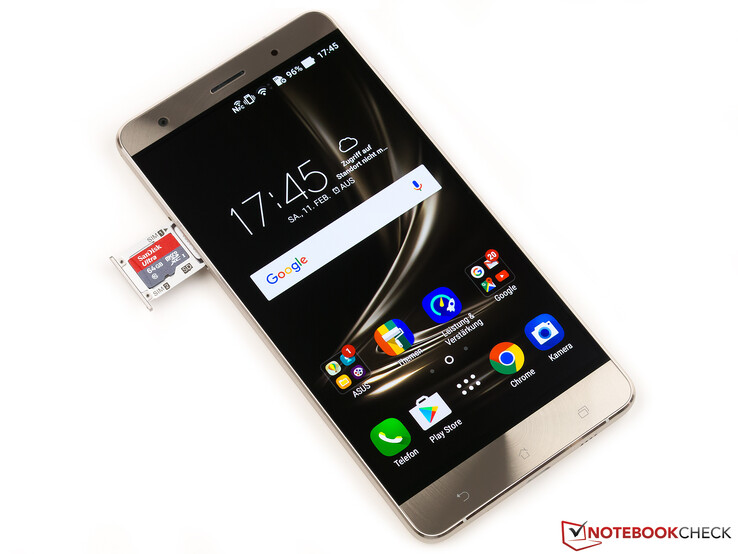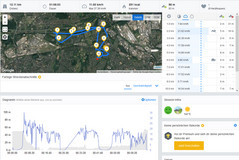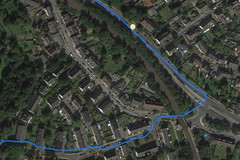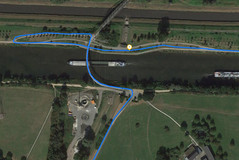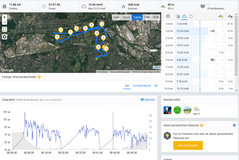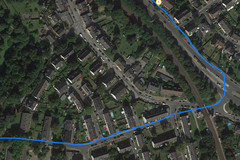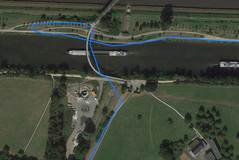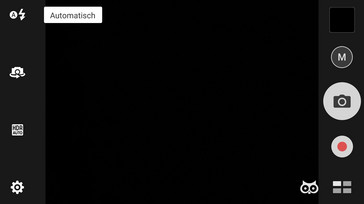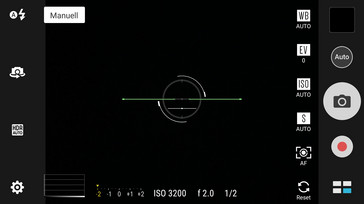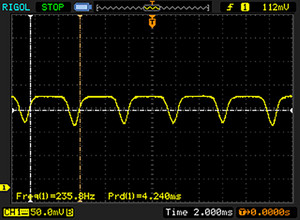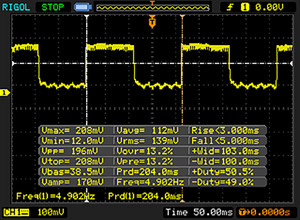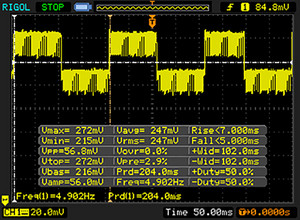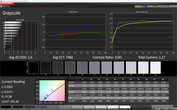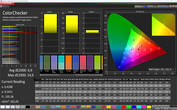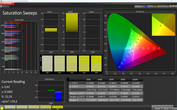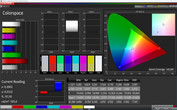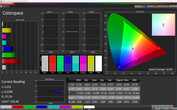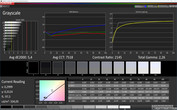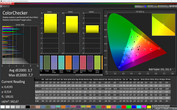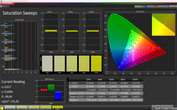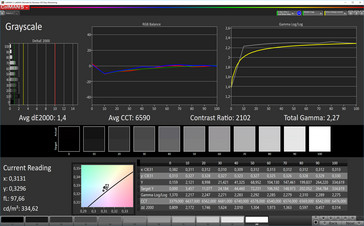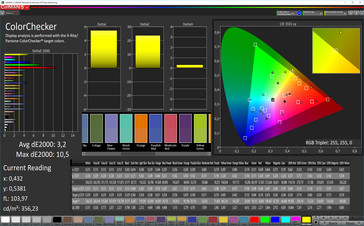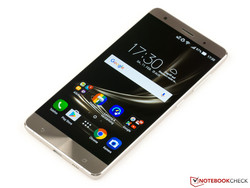华硕 ZenFone 3 Deluxe ZS570KL 智能手机简短评测
» Notebookcheck多媒体笔记本电脑Top 10排名
» Notebookcheck游戏笔记本电脑Top 10排名
» Notebookcheck低价办公/商务笔记本电脑Top 10排名
» Notebookcheck高端办公/商务笔记本电脑Top 10排名
» Notebookcheck工作站笔记本电脑Top 10排名
» Notebookcheck亚笔记本电脑Top 10排名
» Notebookcheck超级本产品Top 10排名
» Notebookcheck变形本产品Top 10排名
» Notebookcheck平板电脑Top 10排名
» Notebookcheck智能手机Top 10排名
» Notebookcheck评测过最出色的笔记本电脑屏幕
» Notebookcheck售价500欧元以下笔记本电脑Top 10排名
» Notebookcheck售价300欧元以下笔记本电脑Top 10排名
Size Comparison
| Networking | |
| iperf3 transmit AX12 | |
| Apple iPhone 7 (Klaus I211) | |
| Google Pixel XL 2016 | |
| Samsung Galaxy S7 Edge | |
| OnePlus 3T | |
| Huawei Mate 9 | |
| Asus ZenFone 3 Deluxe ZS570KL | |
| iperf3 receive AX12 | |
| Apple iPhone 7 (Klaus I211) | |
| Google Pixel XL 2016 | |
| Samsung Galaxy S7 Edge | |
| Huawei Mate 9 | |
| OnePlus 3T | |
| Asus ZenFone 3 Deluxe ZS570KL | |
| |||||||||||||||||||||||||
Brightness Distribution: 85 %
Center on Battery: 619 cd/m²
Contrast: ∞:1 (Black: 0 cd/m²)
ΔE Color 3.2 | 0.5-29.43 Ø5
ΔE Greyscale 1.4 | 0.57-98 Ø5.3
Gamma: 2.27
| Asus ZenFone 3 Deluxe ZS570KL AMOLED, 1920x1080, 5.70 | Samsung Galaxy S7 Edge Super AMOLED, 2560x1440, 5.50 | Lenovo Moto Z AMOLED, 2560x1440, 5.50 | Huawei Mate 9 IPS, 1920x1080, 5.90 | Google Pixel XL 2016 AMOLED, 2560x1440, 5.50 | Apple iPhone 7 Plus IPS, 1920x1080, 5.50 | Microsoft Lumia 950 XL AMOLED, 2560x1440, 5.70 | |
|---|---|---|---|---|---|---|---|
| Screen | |||||||
| Brightness middle | 464 | 554 19% | 485 5% | 696 50% | 402 -13% | 557 20% | 297 -36% |
| Brightness | 468 | 552 18% | 490 5% | 680 45% | 408 -13% | 553 18% | 297 -37% |
| Brightness Distribution | 85 | 96 13% | 92 8% | 93 9% | 85 0% | 97 14% | 93 9% |
| Black Level * | 0.42 | 0.35 | |||||
| Colorchecker dE 2000 * | 3.2 | 1.59 50% | 2.1 34% | 4.3 -34% | 4 -25% | 1.4 56% | 2.67 17% |
| Colorchecker dE 2000 max. * | 10.5 | 2.56 76% | 5.5 48% | 9.4 10% | 10.1 4% | 3.1 70% | 3.98 62% |
| Greyscale dE 2000 * | 1.4 | 2.01 -44% | 2.6 -86% | 4.8 -243% | 3.2 -129% | 1.3 7% | 2.81 -101% |
| Gamma | 2.27 97% | 2.01 109% | 2.23 99% | 2.33 94% | 2.19 100% | 2.21 100% | 2.08 106% |
| CCT | 6590 99% | 6321 103% | 6843 95% | 7255 90% | 7037 92% | 6667 97% | 6379 102% |
| Color Space (Percent of AdobeRGB 1998) | 82.12 | 88.14 | 63.1 | 66.31 | |||
| Color Space (Percent of sRGB) | 99.98 | 100 | 99.83 | 99.79 | |||
| Contrast | 1657 | 1591 |
* ... smaller is better
Screen Flickering / PWM (Pulse-Width Modulation)
| Screen flickering / PWM detected | 235.8 Hz | ||
The display backlight flickers at 235.8 Hz (worst case, e.g., utilizing PWM) . The frequency of 235.8 Hz is relatively low, so sensitive users will likely notice flickering and experience eyestrain at the stated brightness setting and below. In comparison: 53 % of all tested devices do not use PWM to dim the display. If PWM was detected, an average of 17924 (minimum: 5 - maximum: 3846000) Hz was measured. | |||
Display Response Times
| ↔ Response Time Black to White | ||
|---|---|---|
| 8 ms ... rise ↗ and fall ↘ combined | ↗ 3 ms rise | |
| ↘ 5 ms fall | ||
| The screen shows fast response rates in our tests and should be suited for gaming. In comparison, all tested devices range from 0.1 (minimum) to 240 (maximum) ms. » 17 % of all devices are better. This means that the measured response time is better than the average of all tested devices (21.5 ms). | ||
| ↔ Response Time 50% Grey to 80% Grey | ||
| 12 ms ... rise ↗ and fall ↘ combined | ↗ 7 ms rise | |
| ↘ 5 ms fall | ||
| The screen shows good response rates in our tests, but may be too slow for competitive gamers. In comparison, all tested devices range from 0.2 (minimum) to 636 (maximum) ms. » 20 % of all devices are better. This means that the measured response time is better than the average of all tested devices (33.7 ms). | ||
| AnTuTu v6 - Total Score (sort by value) | |
| Asus ZenFone 3 Deluxe ZS570KL | |
| Samsung Galaxy S7 Edge | |
| Lenovo Moto Z | |
| Huawei Mate 9 | |
| Google Pixel XL 2016 | |
| Apple iPhone 7 Plus | |
| Microsoft Lumia 950 XL | |
| PCMark for Android - Work performance score (sort by value) | |
| Asus ZenFone 3 Deluxe ZS570KL | |
| Samsung Galaxy S7 Edge | |
| Lenovo Moto Z | |
| Huawei Mate 9 | |
| Google Pixel XL 2016 | |
| GFXBench 3.0 | |
| 1920x1080 1080p Manhattan Offscreen (sort by value) | |
| Asus ZenFone 3 Deluxe ZS570KL | |
| Samsung Galaxy S7 Edge | |
| Lenovo Moto Z | |
| Huawei Mate 9 | |
| Google Pixel XL 2016 | |
| Apple iPhone 7 Plus | |
| Microsoft Lumia 950 XL | |
| on screen Manhattan Onscreen OGL (sort by value) | |
| Asus ZenFone 3 Deluxe ZS570KL | |
| Samsung Galaxy S7 Edge | |
| Lenovo Moto Z | |
| Huawei Mate 9 | |
| Google Pixel XL 2016 | |
| Apple iPhone 7 Plus | |
| Microsoft Lumia 950 XL | |
| GFXBench 3.1 | |
| 1920x1080 Manhattan ES 3.1 Offscreen (sort by value) | |
| Asus ZenFone 3 Deluxe ZS570KL | |
| Samsung Galaxy S7 Edge | |
| Lenovo Moto Z | |
| Huawei Mate 9 | |
| Google Pixel XL 2016 | |
| Apple iPhone 7 Plus | |
| on screen Manhattan ES 3.1 Onscreen (sort by value) | |
| Asus ZenFone 3 Deluxe ZS570KL | |
| Samsung Galaxy S7 Edge | |
| Lenovo Moto Z | |
| Huawei Mate 9 | |
| Google Pixel XL 2016 | |
| Apple iPhone 7 Plus | |
| Mozilla Kraken 1.1 - Total (sort by value) | |
| Asus ZenFone 3 Deluxe ZS570KL | |
| Samsung Galaxy S7 Edge | |
| Lenovo Moto Z | |
| Huawei Mate 9 | |
| Google Pixel XL 2016 | |
| Apple iPhone 7 Plus | |
| Microsoft Lumia 950 XL | |
| Octane V2 - Total Score (sort by value) | |
| Asus ZenFone 3 Deluxe ZS570KL | |
| Samsung Galaxy S7 Edge | |
| Lenovo Moto Z | |
| Huawei Mate 9 | |
| Google Pixel XL 2016 | |
| Apple iPhone 7 Plus | |
| Microsoft Lumia 950 XL | |
| WebXPRT 2015 - Overall (sort by value) | |
| Asus ZenFone 3 Deluxe ZS570KL | |
| Samsung Galaxy S7 Edge | |
| Lenovo Moto Z | |
| Huawei Mate 9 | |
| Google Pixel XL 2016 | |
| Apple iPhone 7 Plus | |
| Microsoft Lumia 950 XL | |
| JetStream 1.1 - Total Score (sort by value) | |
| Asus ZenFone 3 Deluxe ZS570KL | |
| Samsung Galaxy S7 Edge | |
| Lenovo Moto Z | |
| Huawei Mate 9 | |
| Google Pixel XL 2016 | |
| Apple iPhone 7 Plus | |
| Microsoft Lumia 950 XL | |
* ... smaller is better
| Asus ZenFone 3 Deluxe ZS570KL | Samsung Galaxy S7 Edge | Lenovo Moto Z | Huawei Mate 9 | Google Pixel XL 2016 | Apple iPhone 7 Plus | Microsoft Lumia 950 XL | |
|---|---|---|---|---|---|---|---|
| AndroBench 3-5 | |||||||
| Random Read 4KB | 100.9 | 86.7 -14% | 117.2 16% | 94.7 -6% | 87.7 -13% | ||
| Random Write 4KB | 14.55 | 15.79 9% | 74.9 415% | 8.77 -40% | 14.56 0% | ||
| Sequential Write 256KB | 163.1 | 145.1 -11% | 168.3 3% | 142.9 -12% | 83.4 -49% | ||
| Sequential Read 256KB | 409 | 487.3 19% | 439.7 8% | 594 45% | 258.2 -37% | ||
| Sequential Write 256KB SDCard | 59 | 50.4 -15% | 45.64 -23% | 29.53 -50% | |||
| Sequential Read 256KB SDCard | 77.8 | 76.4 -2% | 78.5 1% | 54 -31% | |||
| BaseMark OS II | |||||||
| Memory | 2051 | 2072 1% | 2190 7% | 3850 88% | 1677 -18% | 1319 -36% | 1945 -5% |
| Asphalt 8: Airborne | |||
| Settings | Value | ||
| high | 30 fps | ||
| very low | 30 fps | ||
| Dead Trigger 2 | |||
| Settings | Value | ||
| high | 59 fps | ||
(±) The maximum temperature on the upper side is 40.9 °C / 106 F, compared to the average of 35 °C / 95 F, ranging from 21.9 to 56 °C for the class Smartphone.
(+) The bottom heats up to a maximum of 39.7 °C / 103 F, compared to the average of 33.8 °C / 93 F
(+) In idle usage, the average temperature for the upper side is 28 °C / 82 F, compared to the device average of 32.7 °C / 91 F.
Asus ZenFone 3 Deluxe ZS570KL audio analysis
(±) | speaker loudness is average but good (78.9 dB)
Bass 100 - 315 Hz
(-) | nearly no bass - on average 19.9% lower than median
(±) | linearity of bass is average (14% delta to prev. frequency)
Mids 400 - 2000 Hz
(±) | higher mids - on average 8.1% higher than median
(±) | linearity of mids is average (9.7% delta to prev. frequency)
Highs 2 - 16 kHz
(±) | higher highs - on average 5.8% higher than median
(±) | linearity of highs is average (13.5% delta to prev. frequency)
Overall 100 - 16.000 Hz
(±) | linearity of overall sound is average (28.9% difference to median)
Compared to same class
» 72% of all tested devices in this class were better, 4% similar, 24% worse
» The best had a delta of 12%, average was 38%, worst was 134%
Compared to all devices tested
» 84% of all tested devices were better, 3% similar, 13% worse
» The best had a delta of 4%, average was 25%, worst was 134%
Samsung Galaxy S7 Edge audio analysis
(+) | speakers can play relatively loud (88.7 dB)
Bass 100 - 315 Hz
(-) | nearly no bass - on average 27.4% lower than median
(±) | linearity of bass is average (8.7% delta to prev. frequency)
Mids 400 - 2000 Hz
(+) | balanced mids - only 4.4% away from median
(+) | mids are linear (4.7% delta to prev. frequency)
Highs 2 - 16 kHz
(±) | higher highs - on average 5.8% higher than median
(+) | highs are linear (6.2% delta to prev. frequency)
Overall 100 - 16.000 Hz
(±) | linearity of overall sound is average (20.6% difference to median)
Compared to same class
» 29% of all tested devices in this class were better, 9% similar, 62% worse
» The best had a delta of 12%, average was 38%, worst was 134%
Compared to all devices tested
» 50% of all tested devices were better, 8% similar, 42% worse
» The best had a delta of 4%, average was 25%, worst was 134%
| Off / Standby | |
| Idle | |
| Load |
|
| Asus ZenFone 3 Deluxe ZS570KL 3000 mAh | Samsung Galaxy S7 Edge 3600 mAh | Lenovo Moto Z 2600 mAh | Huawei Mate 9 4000 mAh | Google Pixel XL 2016 3450 mAh | Apple iPhone 7 Plus 2915 mAh | Microsoft Lumia 950 XL 3340 mAh | |
|---|---|---|---|---|---|---|---|
| Power Consumption | 11% | 22% | -20% | 23% | -19% | -113% | |
| Idle Minimum * | 0.85 | 0.63 26% | 0.66 22% | 0.78 8% | 0.53 38% | 0.77 9% | 2.85 -235% |
| Idle Average * | 1.2 | 1.1 8% | 1.01 16% | 2.13 -78% | 1.07 11% | 2.04 -70% | 2.95 -146% |
| Idle Maximum * | 1.25 | 1.56 -25% | 1.09 13% | 2.17 -74% | 1.12 10% | 2.24 -79% | 3.26 -161% |
| Load Average * | 6.97 | 5.95 15% | 3.97 43% | 6.32 9% | 5.53 21% | 4.69 33% | 8.92 -28% |
| Load Maximum * | 9.74 | 6.7 31% | 8.34 14% | 6.49 33% | 6.26 36% | 8.66 11% | 9.39 4% |
* ... smaller is better
| Asus ZenFone 3 Deluxe ZS570KL 3000 mAh | Samsung Galaxy S7 Edge 3600 mAh | Lenovo Moto Z 2600 mAh | Huawei Mate 9 4000 mAh | Google Pixel XL 2016 3450 mAh | Apple iPhone 7 Plus 2915 mAh | Microsoft Lumia 950 XL 3340 mAh | |
|---|---|---|---|---|---|---|---|
| Battery Runtime | 64% | 23% | 35% | 6% | 28% | -12% | |
| Reader / Idle | 1393 | 1663 19% | 1371 -2% | 1538 10% | 1333 -4% | 1835 32% | 1078 -23% |
| H.264 | 799 | 914 14% | 724 -9% | 947 19% | 505 -37% | 813 2% | 611 -24% |
| WiFi v1.3 | 463 | 732 58% | 407 -12% | 758 64% | 505 9% | 587 27% | 369 -20% |
| Load | 149 | 392 163% | 320 115% | 219 47% | 230 54% | 225 51% | 179 20% |
Pros
Cons
华硕ZenFone 3 Deluxe在一入手时就给了我们很好的印象,它的高品质坚固金属机身质感十足。在机身内,它搭载了128GB UFS 2.0闪存和6GB大容量内存和骁龙处理器,这台设备完全可以和其他2016年以来的高端设备相抗衡。它的连接性功能包括了一个USB-C接口,可选的一直开启屏幕功能,和第二个SIM卡/microSD兼容插槽,这些都让它更方便使用。它搭配的两个高分辨率相机都表现十分不错。其中主相机更是支持速度很快的自动对焦系统。不过它也还有一些可以改进的方面,特别是暗光下的拍摄效果以及经常略带颗粒感的拍摄质量。高分辨率的AMOLED屏幕5.7寸的显示空间十分宽阔,由于仅全高清的分辨率,这台设备并不完全适合VR应用。华硕改进后的ZenUI 3.0界面带来了更多的功能,不过用户可能不是所有用户都会对它占用的19GB存储空间感到高兴。另外,一些竞争机型提供了比它更长的电池续航。
不需要对VR应用支持、喜欢它丰富的用户界面的用户,将会得到一台高品质的高端智能手机,华硕ZenFone 3 Deluxe的弱点屈指可数。
不过,它是否有足够的亮点来支持它799欧元(约5790人民币)的售价并不好说,特别是与一些正在降价的同类机型相对比的话。它并没有像三星 Galaxy S7 Edge一样的弧形屏幕边缘,也不支持联想 Moto Z风格的功能模块。它没有Apple iPhone的标志性地位,软件更新也不如谷歌Pixel XL及时。另一方面,需要更大屏幕的用户可能会更喜欢华为 Mate 9。但不论如何归功于先进的科技、双SIM卡功能和成熟的设计,ZenFone 3 Deluxe在高端机型中仍然是一台十分值得考虑的设备。
注:本文是基于完整评测的缩减版本,阅读完整的英文评测,请点击这里。
Asus ZenFone 3 Deluxe ZS570KL
-
02/16/2017 v6(old)
Andreas Kilian


 Deutsch
Deutsch English
English Español
Español Français
Français Italiano
Italiano Nederlands
Nederlands Polski
Polski Português
Português Русский
Русский Türkçe
Türkçe Svenska
Svenska Chinese
Chinese Magyar
Magyar